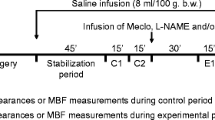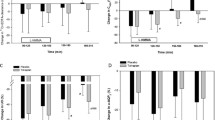Abstract.
The renal vascular response to vasopressin and its modulation were evaluated in vivo by infusing the peptide directly into the renal artery of anaesthetized rats. The intra-renal artery (i.r.a) infusion of vasopressin induced a dose-dependent decrease in renal blood flow. Vasoconstriction was obvious at a dose of 3 ng/kg per min and reached a maximum at 100 ng/kg per min. The dose required for a half-maximal response (ED50) was 24±4 ng/kg per min (mean±SEM, n=8), corresponding to an estimated concentration in renal arterial blood required for a half-maximal response (EC50) of 1.9±0.6 nM. Thiobutabarbitone anaesthesia markedly increased plasma vasopressin concentration. This increase was prevented partially by hypotonic hydration of the rats without any change in the renal vascular response to exogenous vasopressin. Vasopressin-induced vasoconstriction dose/response curves were similar in homozygous and heterozygous Brattleboro rats. Infusion of desmopressin (1–1000 ng/kg per min, i.r.a.), a vasopressin V2 receptor-selective agonist, failed to induce renal vasodilation or vasoconstriction. In the presence of SR 49059 (1 mg/kg i.v.), a vasopressin V1A receptor antagonist that completely abolished the vasopressin-induced renal vasoconstriction, desmopressin again failed to induce vasodilation. Inhibition of nitric oxide synthase by N ω-nitro-l-arginine (L-NNA, 100 µg/kg for 10 min and 7.5 µg/kg per min, i.r.a.) enhanced vasopressin-induced renal vasoconstriction (EC50 0.6±0.1 nM, P<0.05). In contrast, cyclooxygenase blockade by indomethacin (5 mg/kg, i.v.) neither modified the vasopressin-induced decrease in renal blood flow nor altered the potentiation of vasoconstriction by L-NNA.
These results show that the constrictor response of the rat renal vascular bed in vivo is observed only with high local concentrations of vasopressin. This hyporeactivity in vivo was not explained by an anaesthesia-elicited increase in endogenous vasopressin, nor by a modulatory effect linked to V2 receptor activation or prostanoid release. In contrast, NO release contributed to the attenuation of vasopressin-induced renal vasoconstriction.
Similar content being viewed by others
Author information
Authors and Affiliations
Additional information
Electronic Publication
Rights and permissions
About this article
Cite this article
Loichot, C., Cazaubon, C., De Jong, W. et al. Nitric oxide, but not vasopressin V2 receptor-mediated vasodilation, modulates vasopressin-induced renal vasoconstriction in rats. Naunyn-Schmiedeberg's Arch Pharmacol 361, 319–326 (2000). https://doi.org/10.1007/s002109900187
Received:
Accepted:
Issue Date:
DOI: https://doi.org/10.1007/s002109900187




